Last-Minute NYC Holiday Gift Guide 🎁
We’ve created a holiday gift guide with presents for the intrepid New Yorker that should arrive just in time—


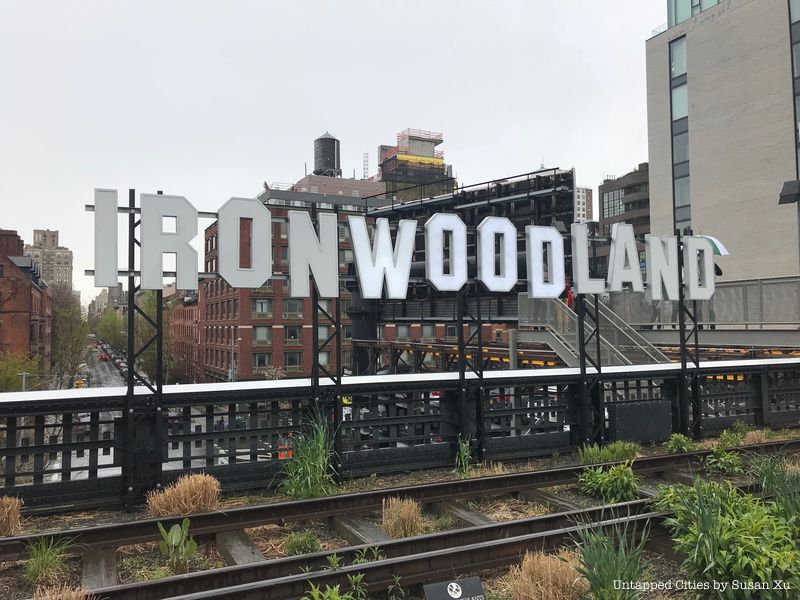
While New York City serves as a year-round launchpad for dynamic exhibits and eye-catching works, spring is particularly bountiful when it comes to the arrival of public art. With the drawn out close of winter comes a new wave of outdoor installations: this month will first heat up with new large-scale sculptures at the High Line and the Broadway Malls. Additionally, the International Center of Photography is paying tribute to those incarcerated during World War II, the Center for Architecture will focus on the story of affordable housing, and the Queens Museum is reexamining our history with slaves and guns.
Beyond these exhibits, make sure to also keep an eye out for public art coming to historic places across the city. Here are 17 art installations and exhibits not to miss this April:
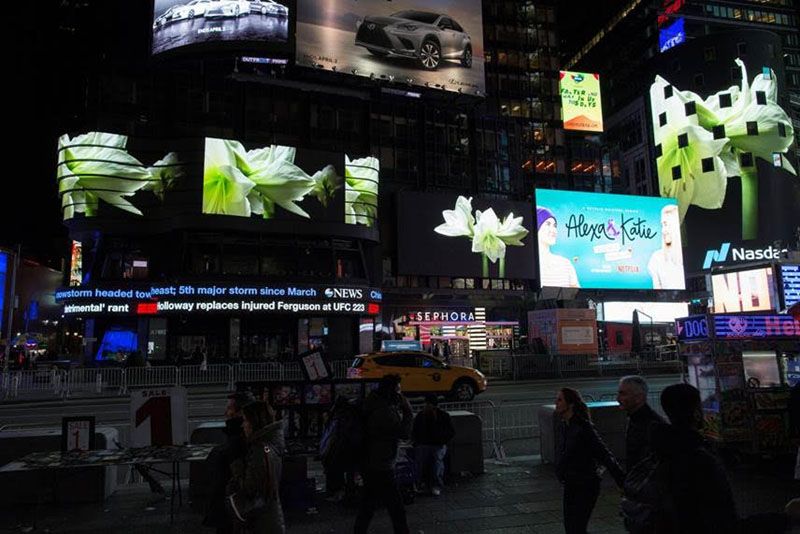
Image via Ka-Man Tse for Time Square Arts
The Times Square Advertising Coalition’s newest Midnight Moment exhibition features artist Jamie Scott’s Spring, in partnership with Vimeo Staff Picks and curated by Times Square Arts.
Shot in stunning 4K Ultra High Definition with a moving time-lapse camera, Spring is a “romantic, evocative portrayal of New York’s flowers in active bloom.” As part of Midnight Moment — the world’s largest, longest-running digital art exhibition, which synchronizes with Time Square’s electronic billboards nightly from 11:57pm to midnight — Spring will air from April 1st to the 30th. See an Instagram video of it here.

Phyllida Barlow’s prop. Photo via the High Line
Phyllida Barlow: prop will be the first artwork ever to be presented on the North Spur Preserve of The High Line. Consisting of two large concrete panels with holes cut from their centers, and set on stilts, the installation appears like a character teetering among planks and emerging from the planting beds below it. A prime example of adaptive reuse, The High Line provides the perfect context for Barlow, known for her use of throwaway materials, and the presentation of her work. The sculpture, which viewers will be able to see from the street below, will stand on a railway spur at 16th Street that used to run directly into a refrigerated warehouse northwest of the former Nabisco cookie factory.
Phyllida Barlow: prop will be on view from April 19th, 2018 to March 2019. While you’re there, make sure to also check out The High Line’s new installations, entitled AGORA, unveiling on the same day (read more below).

Another outdoor art installation, AGORA, is coming to The High Line. This group exhibition by nine artists will explore the role of art and artists in defining, creating, and using public space. The name of the exhibit is inspired by the same ancient Greek word, which literally translates to a gathering place — a fitting name as New York City’s public spaces have served as a home to a plethora of artworks over the decades, ranging from WPA murals to graffiti tags.
AGORA will focus on the power of art to change society. As such, it will address current issues, including women’s rights, mass incarceration, the environment and immigration. For instance, the work above, “C.R.E.A.M.,” by Sable Elyse Smith, is an altered replica of the Hollywood Sign that reads IRONWOODLAND — a reference both to the Ironwood State Prison and to “Hollywoodland,” the segregated real estate development that was advertised by the original sign. The exhibit will be on view from April 19th, 2018 to March 2019 at various locations along The High Line.
As the adorable bronze figures by Joy Brown on the Broadway Malls come down, the Broadway Mall Association has been preparing for the debut of Kathy Ruttenberg on Broadway: In Dreams Awake. The new exhibit, which will be installed the week of April 15th, includes six works that will be featured on the Broadway center mediums, located on 64th, 72nd, 79th, 96th, 116th, and 157th Streets. Each sculpture — described as a combination of human, animal and plant forms — is made from cast silicon bronze, and will range between 6 feet to 15 feet in height. (Some will even feature LED lighting!)
The opening of Kathy Ruttenberg on Broadway: In Dreams Awake will be celebrated with a ribbon cutting ceremony at 11am on April 27th, at the south entrance to 72nd Street #1 train. The exhibit will be on view through February 2019.

As the second part of its NYC Trash!: Past, Present & Future exhibit, The City Reliquary will debut an outdoor trash garden, highlighting the work of ten local ‘trash artists.’ Among the works that will be on view include Bernard Klevickas’ sculptures made from salvaged bicycle parts; Niki Lederer’s hanging pieces made from colorful, repurposed plastic; Barbara Lubliner’s plastic bottle succulent garden; and Claudia Sbrissa’s artwork inspired by landscapes.
The sculpture garden will be on view April 7th to April 29th, 2018, with an opening reception from noon to 3pm on Saturday April 7th. During the reception, the Wildlife Conservation Corp (WCC) will screen 2 Lost Soles, a film about the urgency of conservation, and poet Jacqueline Ottman will read from her book, If Trash Could Talk. The City Reliquary is located at 370 Metropolitan Avenue in Brooklyn. Read more about the exhibition here.

In March, Gillie and Marc unveiled the world’s largest rhino statue, The Last Three, at Astor Place in an attempt to bring awareness to wildlife conservation and to encourage the global community to end rhino horn sales. In preparation for the piece, the artists spent a week at Kenya’s Ol Pejeta Conservancy observing the world’s final three Northern White Rhinos, Sudan and his infertile daughters Najin and Fatu. (Devastatingly, Sudan has since passed away due to an age-related medical condition.)
The Last Three by Gillie and Marc is now on view at Astor Place. Read more about the sculpture here. You may have also encountered Gillie and Marc’s other unique and fun-loving installations around the city, from Paparazzi Dogs in DUMBO and Greenwich Village, to Dogman and Rabbitgirl at the Table of Love — each with a message encouraging conversation.
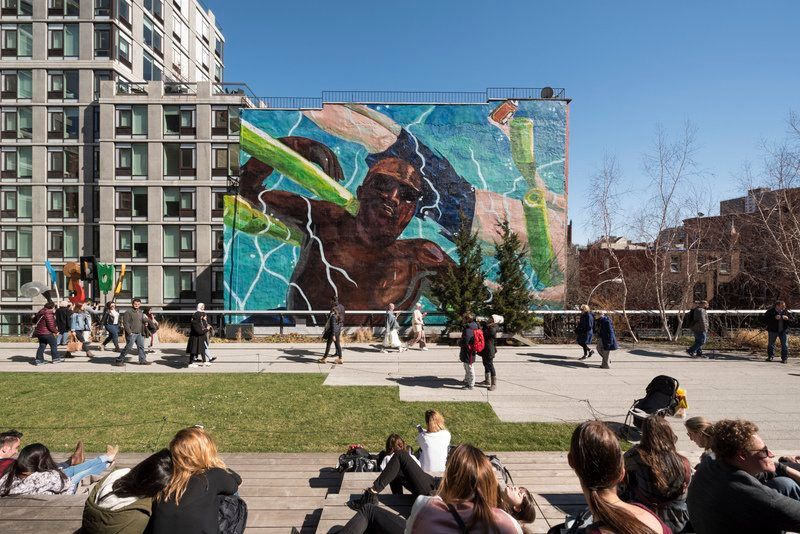 Photo by Timothy Schecnk courtesy High Line Art
Photo by Timothy Schecnk courtesy High Line Art
The very controversial artist, Dorothy Iannone, has something to say, and High Line Art has received her message with the debut of her large-scale mural installation at 22nd Street on the High Line. The piece, which pays homage to “freedom promised by immigration to America,” features three colorful Statues of Liberty, with the words “I Life My Lamp Beside the Golden Door” running between them. The excerpt is taken from Emma Lazarus’s poem, “The New Colossus,” engraved on a bronze plaque mounted inside the Statue of Liberty.
Dorothy Iannone’s “I Life My Lamp Beside the Golden Door” is on view through to March 2019 at 22nd Street. Read more about the installation here.
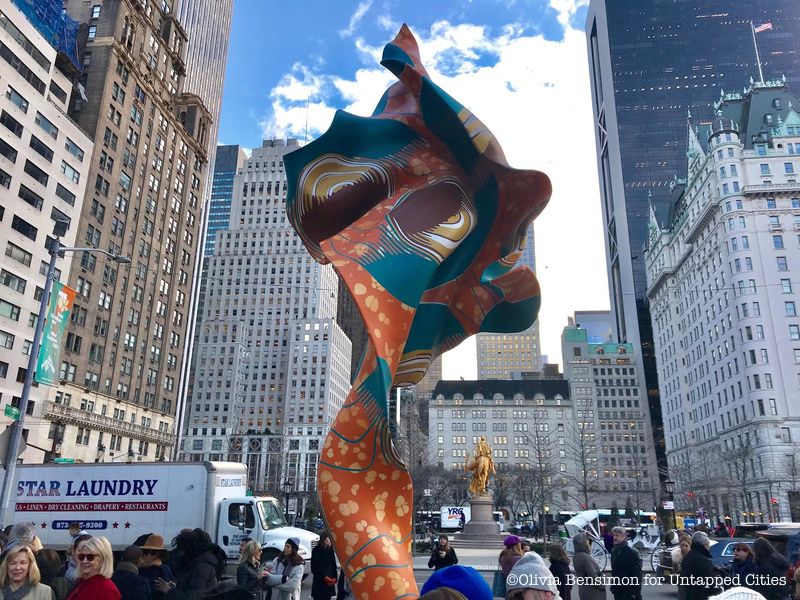
Earlier last month, The Public Art Fund debuted Yinka Shonibare MBE: Wind Sculpture (SG) 1, now on view at the Doris C. Freedman Plaza at Central Park. The 23-foot-tall installation by British-Nigerian artist, Yinka Shonibare MBE, is “reminiscent of the untethered sail of a ship billowing in the breeze.” It features a hand-painted pattern inspired by Dutch wax batik prints, and incorporates swaths of turquoise, red and orange — colors associated with the artist’s childhood on the beaches of Lagos.
Wind Sculpture (SG) 1 is a continuation of a series of installations that examine cultural identity through the lens of colonialism. The previous installation, entitled Wind Sculpture VII, is a permanent fixture outside the Smithsonian National Museum of African Art in Washington D.C.
The installation, curated by Public Art Fund Director and Chief Curator, Nicholas Baume, will be on view until October 14th, 2018 at the Doris C. Freedman Plaza, located on Fifth Avenue at 59th Street. Read more about the piece here.
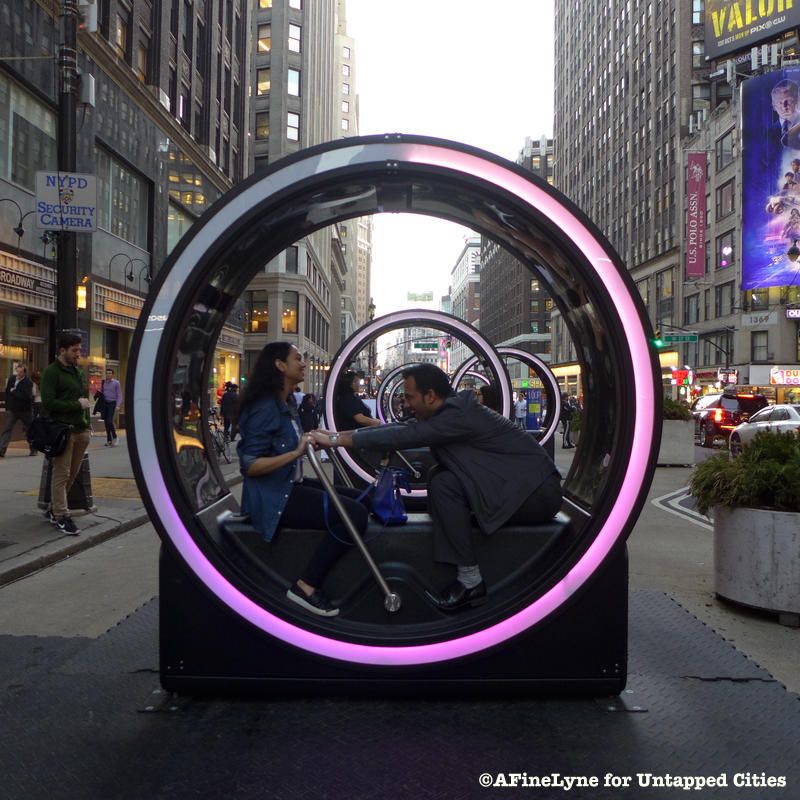
In February, The Garment District Alliance installed retro-futuristic cylinders on The Plaza. LOOP, a series of six cylinder modules — created by artists Olivier Girouard (Ekumen) and Jonathan Villeneuve (concept and execution), Ottoblix (animations), Generique Design (industrial design), Thomas Ouellet Fredericks (electronic design), Adsum Lab (technical support), Jérôme D. Roy (mechanical consultant), and Dominic Thibault (audio programming) — are seven-feet in length, three-feet wide, and nine-feet high. Pedestrians are invited to hop in and pump the movable lever to activate musical films.
“Once the cylinders begin to spin, each will light up and play musical movies that are inspired by 13 fairytales, accompanied by a flickering strobe effect. The speed of the images, frequency of the lights, and tempo of the music are determined by how fast the participants move the lever,” explained the Garment District Alliance. LOOP is part of Garment District Art on the Plazas, a subpart of the New York City Department of Transportation’s Art Program (DOTArt). The installation will be on view on the Broadway medium from 37th to 38th Street through March 31st, 2018. Read more about the installation here.
The exhibition, Marching On: The Politics of Performance, explores the legacy of marching within the African-American community. Commissioned by the Storefront for Art and Architecture, the project interweaves echoes of the 1917 Silent March with references to the Harlem Hellfighters in order to shine light on organized forms of performance as “agents of cultural and political expression,” celebrations of collective identities and the assertion of rights.
As part of Marching On, Storefront partnered with the Marcus Garvey Park Alliance and Performa to present a series of performances during Performa 17, dedicated to “live art.” The project was directed and designed by Bryony Roberts and Mabel Wilson, in collaboration with The Marching Cobras of New York, a Harlem-based after-school drum line and dance team.
Marching On: The Politics of Performance will be on view from April 14th to June 9th, 2018 at the Storefront for Art and Architecture on 97 Kenmare Street. An opening reception will be held on April 14th from 5pm to 7pm (members preview from 4pm to 5pm), with a performance by the Marching Cobras of New York from 5 to 5:30pm. Public opening of the exhibit will take place from 5:30 to 7pm.
The subject of affordable housing in New York City has become a daily headline, especially as the homeless population grows and the city’s housing complexes age. How do other countries address this issue? A current exhibit at the Center for Architecture, Social Housing: New European Projects, displays their best efforts.
The exhibit takes up two floors and showcases 25 European social housing projects by 20 different firms. Each project includes a short description, drawing, rendering and model. From mixed-use housing options to co-op models, the range of public projects challenges us to rethink not only how we build, but also the vital role of accessible, low-cost housing with consideration to high quality design.
Social Housing: New European Projects is on view through May 19th, 2018 at the Center for Architecture, located at 537 LaGuardia Place between West 3rd Street and Bleecker Street in Greenwich Village.

Dorothea Lange, Centerville, California, May 9, 1942. Courtesy National Archives and Records Administration
The Executive Order 9066, signed by President Franklin D. Roosevelt in 1942, set in motion the forced removal and imprisonment of all people of Japanese ancestry living on the West Coast. The exhibition, Then They Came for Me: Incarceration of Japanese Americans during World War II by the International Center of Photography, features 100 images taken by renowned photographers who sought to document the lives of Japanese Americans in incarceration camps and their forced eviction from their homes. During this time, the United States Government incarcerated 120,000 citizens and legal residents. One of them was Tomo Miyatake, whose photographs will also be on display.
Then They Came for Me: Incarceration of Japanese Americans during World War II will be on view until May 6th, 2018 at the International Center of Photography on 250 Bowery.

The Queens Museum and No Longer Empty have come together to co-produce Mel Chin: All Over the Place, featuring more than 70 works, including drawings, sculptures, and videos. Kicking off with an opening reception at the Queens Museum on Sunday, April 8th, the exhibition will proceed to “spill out of the Museum” over the summer and onto various sites across New York City. This includes Times Square, where a 24 x 34 x 60-foot installation evoking the hull of a shipwreck and a 21-foot tall animatronic figurehead of opera star Jenny Lind will be on view. The piece will address this city’s complicated history regarding the shipping of guns and slaves.
The exhibition will be organized around key themes that have resonated throughout Chin’s career, including Chin’s “understanding of democracy as a two-faced ideal, issues of climate change, legacies of colonialism and racism, and their relation to the circulation of goods, and ideas.” Mel Chin: All Over the Place will be on view from April 8th to August 12th, 2018 at the Queens Museum in Flushing Meadows-Corona Park.
Over 100 artworks by Gordon Matta-Clark, an artist trained as an architect, are now on display at The Bronx Museum of the Arts in Gordon Matta-Clark: Anarchitect. The exhibit digs deep into Matta-Clark’s archives, presenting his work through images and film, and bringing to life his energy and enthusiasm.
A product of the 1960s, Matta-Clark has a particular interest in spaces that others believe to have no value, transforming the abandoned into thoughtful installations. On view are examples of his “monumental cuts, holes, apertures, and excisions” to abandoned buildings. The exhibit also explores his creative thought process during a period of great political unrest associated with the Vietnam war, as well as his concern for the homeless and his deep interest in community engagement.
Gordon Matta-Clark: Anarchitect will be on view until April 8th, 2018 at The Bronx Museum of the Arts, located on 1040 Grand Concourse.

Gavin Brown’s enterprise gallery, located in a historic former brewery building in Harlem, features three floors of exhibition space. Currently on view on the ground floor is Frida Orupabo’s, Cables to Rage, a series of collages constructed from her prolific archive of found materials. Mirroring her multi-layered life as an artist and sociologist, her work explores questions surrounding race, family relations, gender, sexuality, violence and identity. Avery Singer‘s Days of the Weak (Computer Pain) can be found on the second floor, where high ceilings, painted steel beams, and brick work — all remnants of the now Landmarked Yuengling Brewing Company (c. 1905) — provide the perfect setting for Singer’s seven pieces, based on the days of the week. Jos De Gruyter and Harald Thys‘ Objects as Friends is exhibited on the fourth floor. In this stunning display of 311 high-resolution photographs of found objects, “each speck of dust is captured precisely…” and the colors are “rendered so accurately as to create a sense of cyber-reality…,” the gallery writes.
Each one of the three exhibits are noteworthy, as is the interior gallery space itself and how it has been preserved, augmented and reused for art and events. Gavin Brown’s enterprise is located at 439 West 127th Street in Harlem. The three exhibits will be on view until April 22nd, 2018.
 The work of artist Jackie Battenfield at Avenue P on the F Train in Brooklyn. Image courtesy Jackie Battenfield.
The work of artist Jackie Battenfield at Avenue P on the F Train in Brooklyn. Image courtesy Jackie Battenfield.
Brooklyn’s Avenue P stop off the F Train will soon welcome a new MTA Arts & Design installation: 28 new laminated glass panels, created by artist Jackie Battenfield, will grace the stairways on the ground platform. The first seven panels are ready for installation now.
The Brooklyn-born artist is known for her luminous paintings and prints, with a focus on the most abstract qualities of landscape, like storms, clouds, brush fires, water ripples, trees and flowers. Also, check out more artwork commissioned by the MTA, including examples of some of original subway art, dating back to the 1980’s.

Image via The Skyscraper Museum
A current exhibit at The Skyscraper Museum, Millennium: Lower Manhattan in the 1990s, takes an in-depth look at Lower Manhattan prior to September 11th. It features displays of architectural drawings and models, archival and contemporary photographs, original posters, maps, sketches, and renderings that capture this particular period of time in New York City history. At a time of reinvention, Millennium, displays projects large and small, built and unbuilt, as architects and planners began to rethink downtown Manhattan and plan for its resurgence. This includes the build-out of Battery Park City’s 92 acres, the reclaimed Hudson River waterfront, the East River Development of South Street Seaport and Fulton Fish Market, among other projects.
One of the highlights of the exhibition is Heritage Trails New York, a program of forty site markers and printed maps implemented in the late 1990s intended to encourage tourism. The project is represented through original materials, which are on display, and also through the museum’s digital recreation of the tours as they were in 1997, alongside how they appeared in 2017. Millennium: Lower Manhattan in the 1990s will be on view at The Skyscraper Museum at 39 Battery Place through April 2018.

Become an Untapped Cities Insider, and join us for exclusive tours of New York City’s most inaccessible places, talks, happy hours and more. Contact the author at AFineLyne.
Subscribe to our newsletter